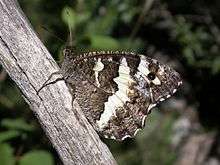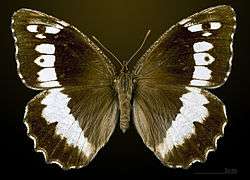Brintesia
| Brintesia | |
|---|---|
 | |
| Brintesia circe | |
| Scientific classification | |
| Kingdom: | Animalia |
| Phylum: | Arthropoda |
| Class: | Insecta |
| Order: | Lepidoptera |
| Suborder: | Glossata |
| Superfamily: | Papilionoidea |
| Family: | Nymphalidae |
| Subfamily: | Satyrinae |
| Genus: | Brintesia Fruhstorfer, 1911 |
| Species: | B. circe |
| Binomial name | |
| Brintesia circe (Fabricius, 1775) | |
| Synonyms | |
| |
Brintesia is a monotypic butterfly genus in the family Nymphalidae and subfamily Satyrinae. Its one species is Brintesia circe, the great banded grayling.
Description
Brintesia circe reaches on average wingspan of 65–80 millimetres (2.6–3.1 in). Its wings are mainly black or dark brown. They have a broad white band at the edge of the basal area of all wings and usually a second white streak on the lower wings. The black eyespots on the underside of the upper wings have a white contour. Brintesia circe is quite similar to Hipparchia fagi, but in the latter the second white streak on the lower wings is always missing and the eyespots have a yellow contour. These butterflies usually rest on the branches of a tree, protected by their cryptic markings, but ready to take off and fly away when disturbed.
 Female
Female Female underside
Female underside Male
Male Male underside
Male underside
Biology
These butterflies fly in one generation from June to September feeding on nectar of flowers. Larvae feed on various herbaceous plants (mainly on Anthoxanthum, Bromus, Festuca and Sesleria species). The young larvae overwinter.
Distribution
The species can be found in central and southern Europe (Spain, France, Italy, Greece, southern Germany and Poland), in Anatolia and the Caucasus up to Iran.
Habitat
These butterflies prefer light woodland, grasslands bordering forest edges and generally dry and bushy environments, at an altitude of 0–1,600 metres (0–5,249 ft) above sea level.
Subspecies
- Brintesia circe pannonia (Fruhstorfer, 1917)
- Brintesia circe venusta (Fruhstorfer, 1909)
Gallery
- On a flower of Dipsacus fullonum
.jpg) On a Buddleia davidii flower
On a Buddleia davidii flower
References
- BioLib.cz
- Fauna Europaea
- "Brintesia Fruhstorfer, 1911" at Markku Savela's Lepidoptera and Some Other Life Forms
External links
- Satyrinae of the Western Palearctic
- Eurobutterflies
- Brintesia circe
- Satyrinae of the Western Palearctic
| Wikimedia Commons has media related to Brintesia circe. |